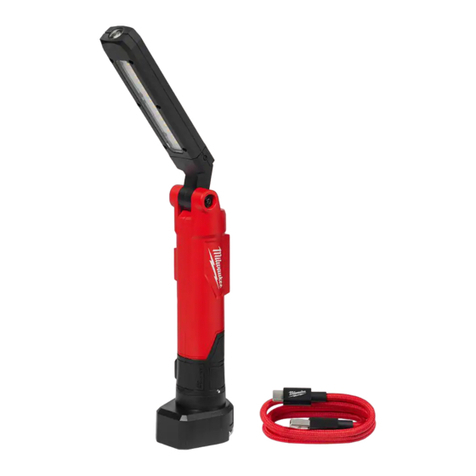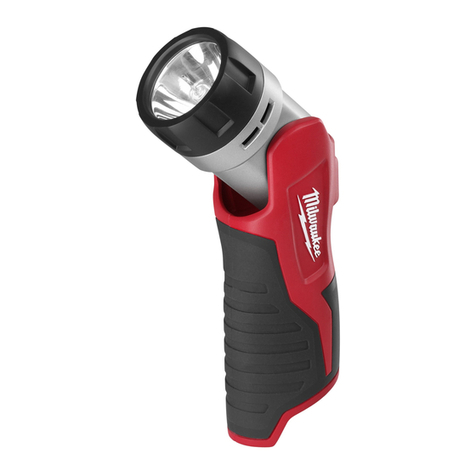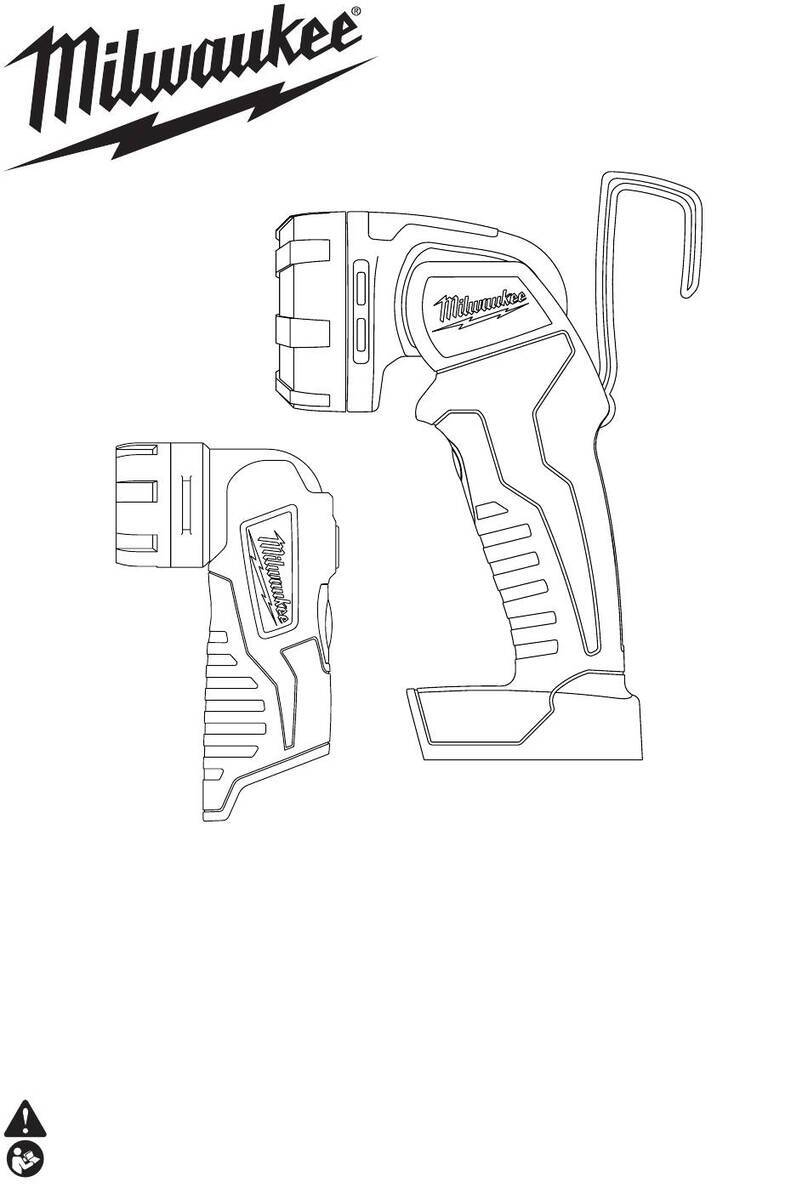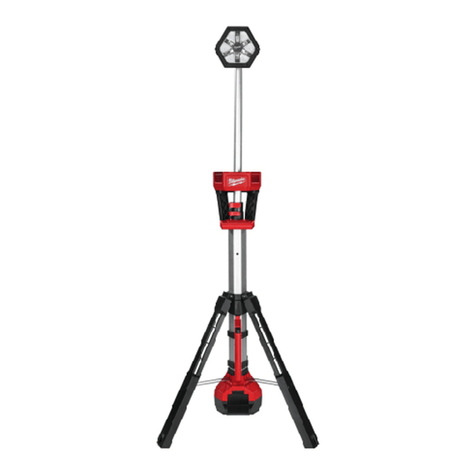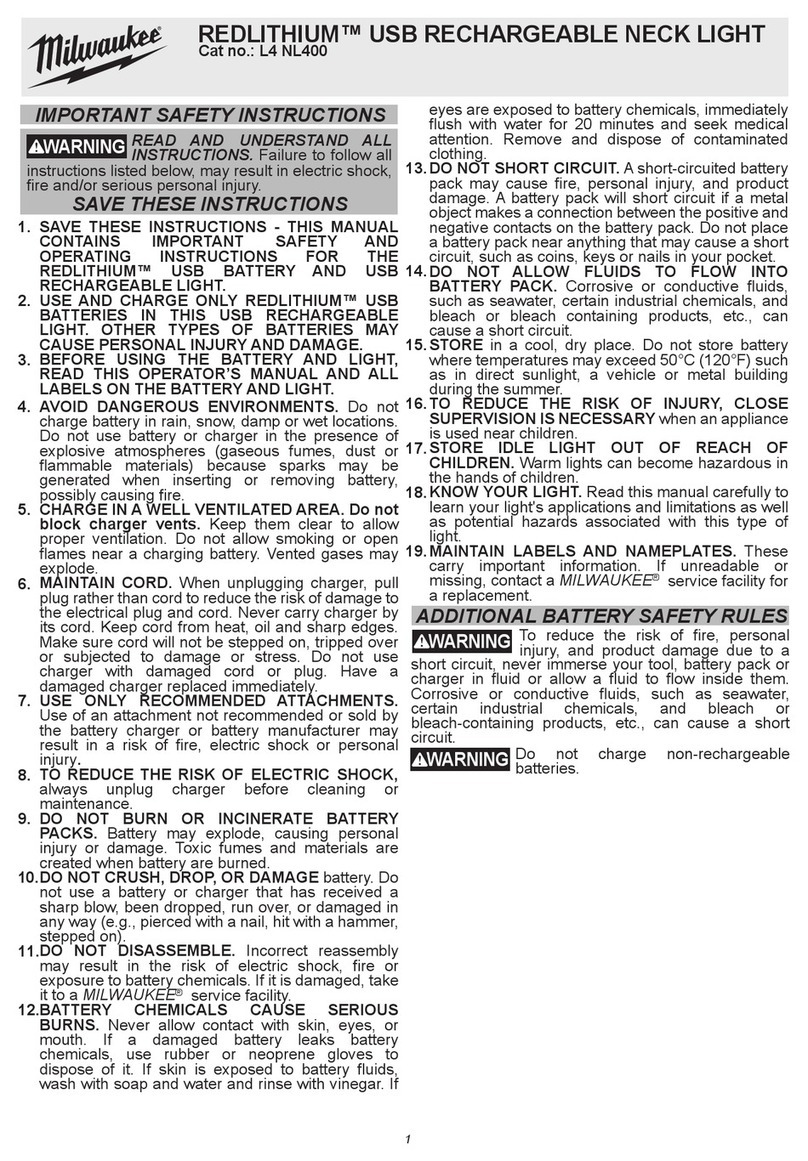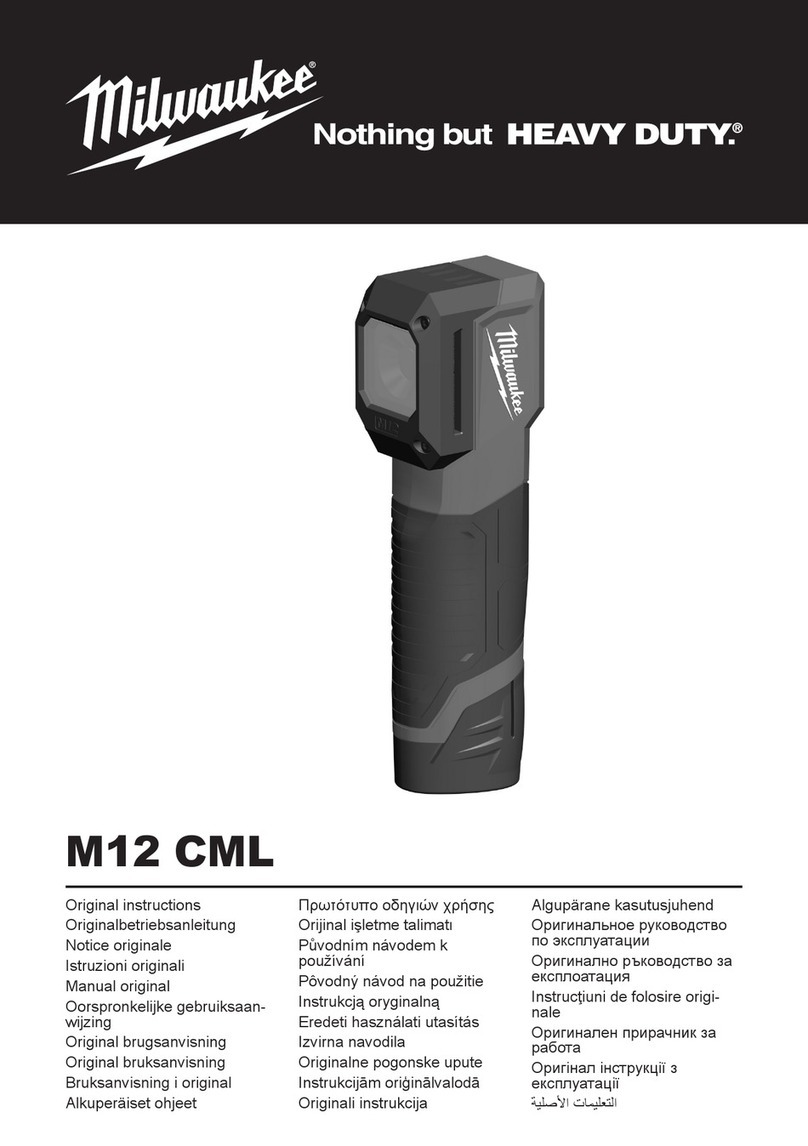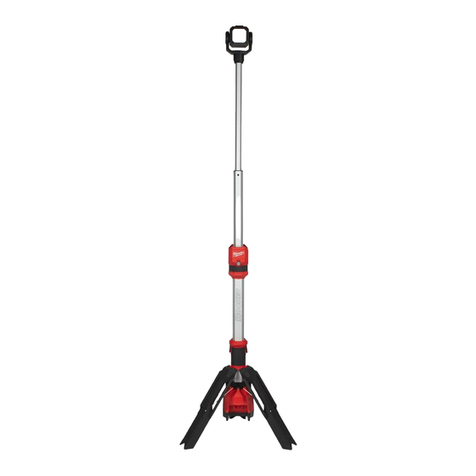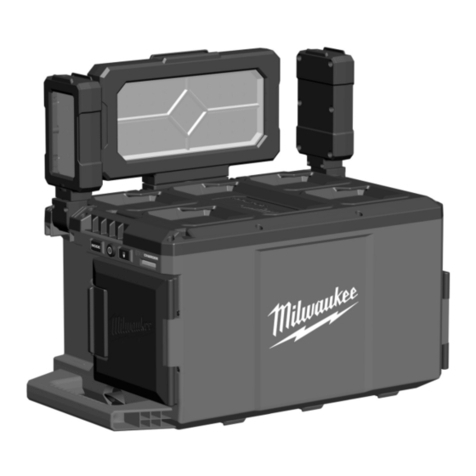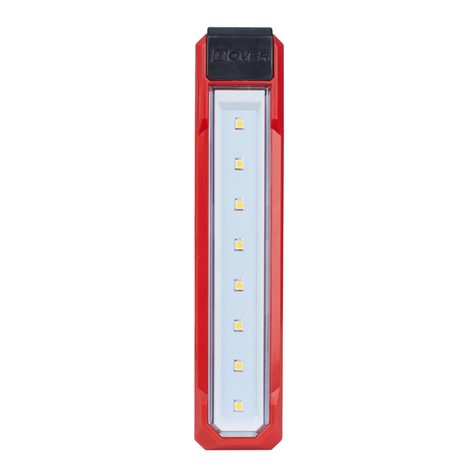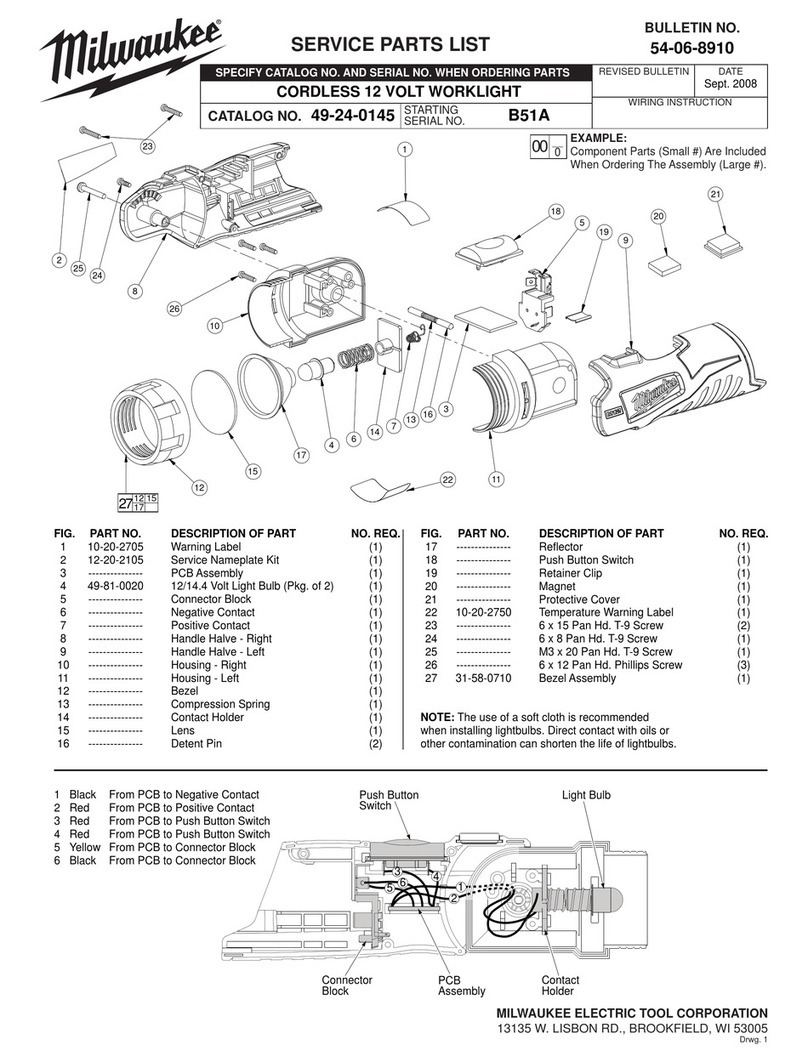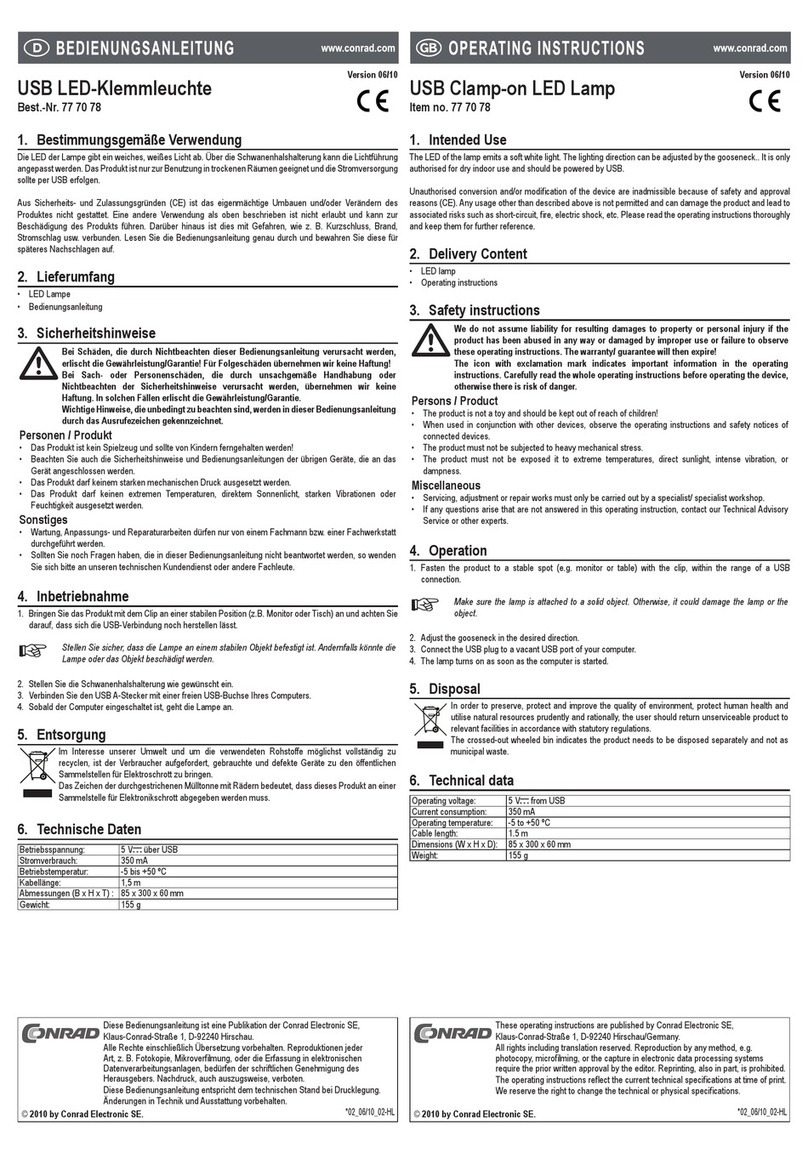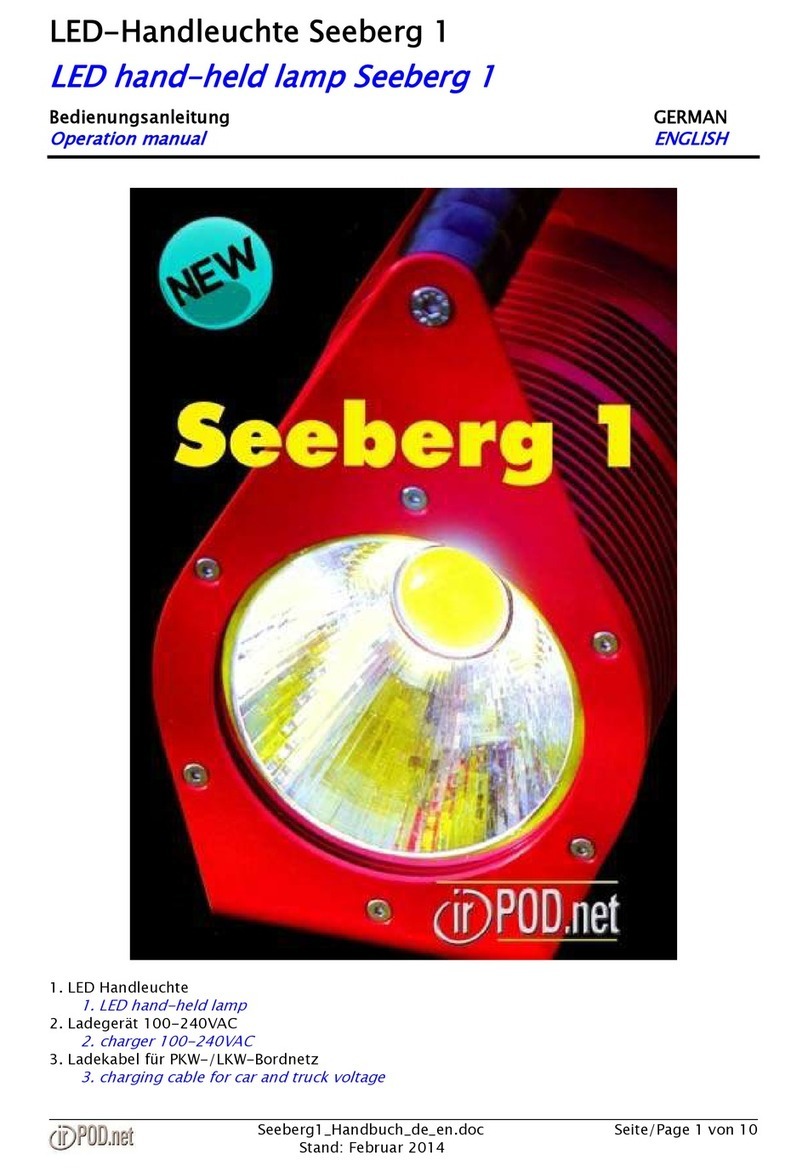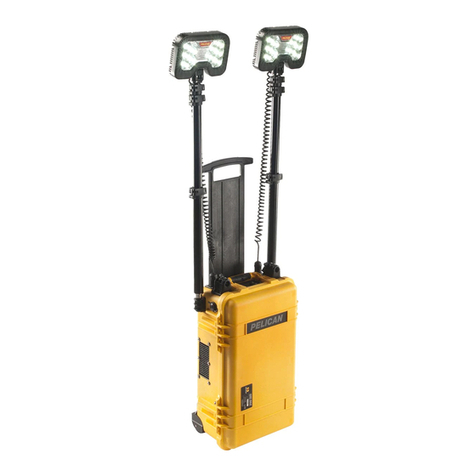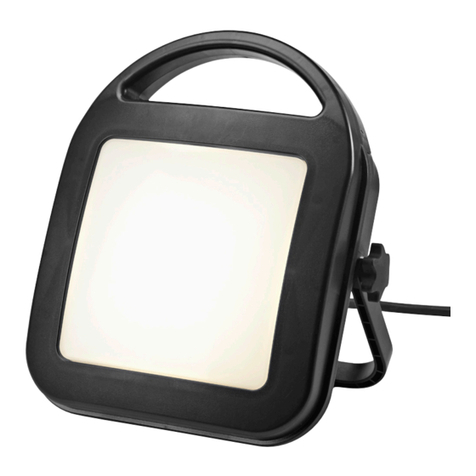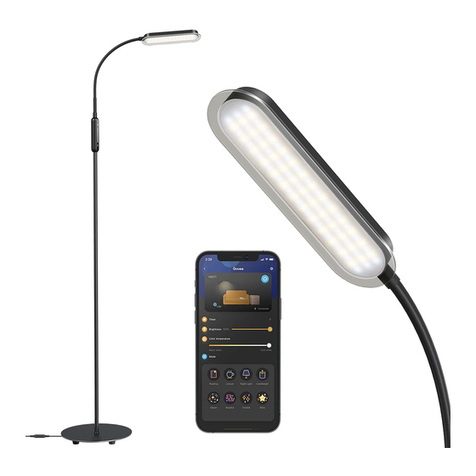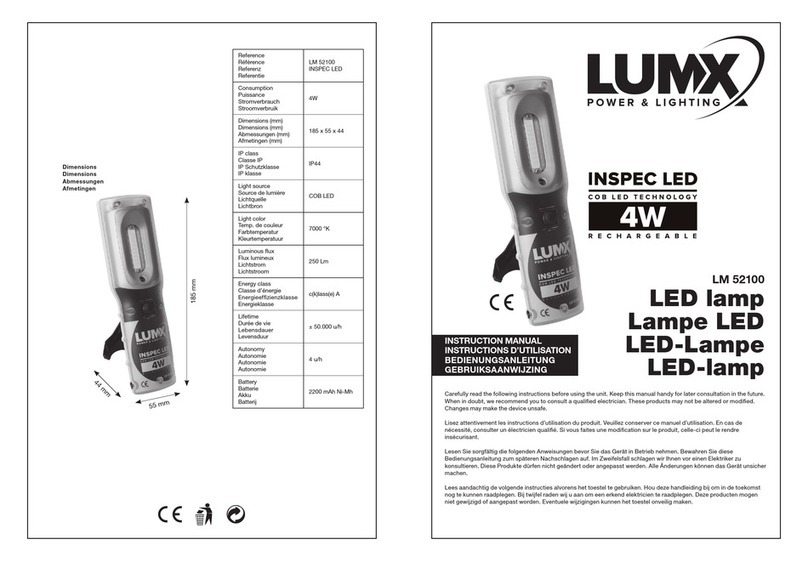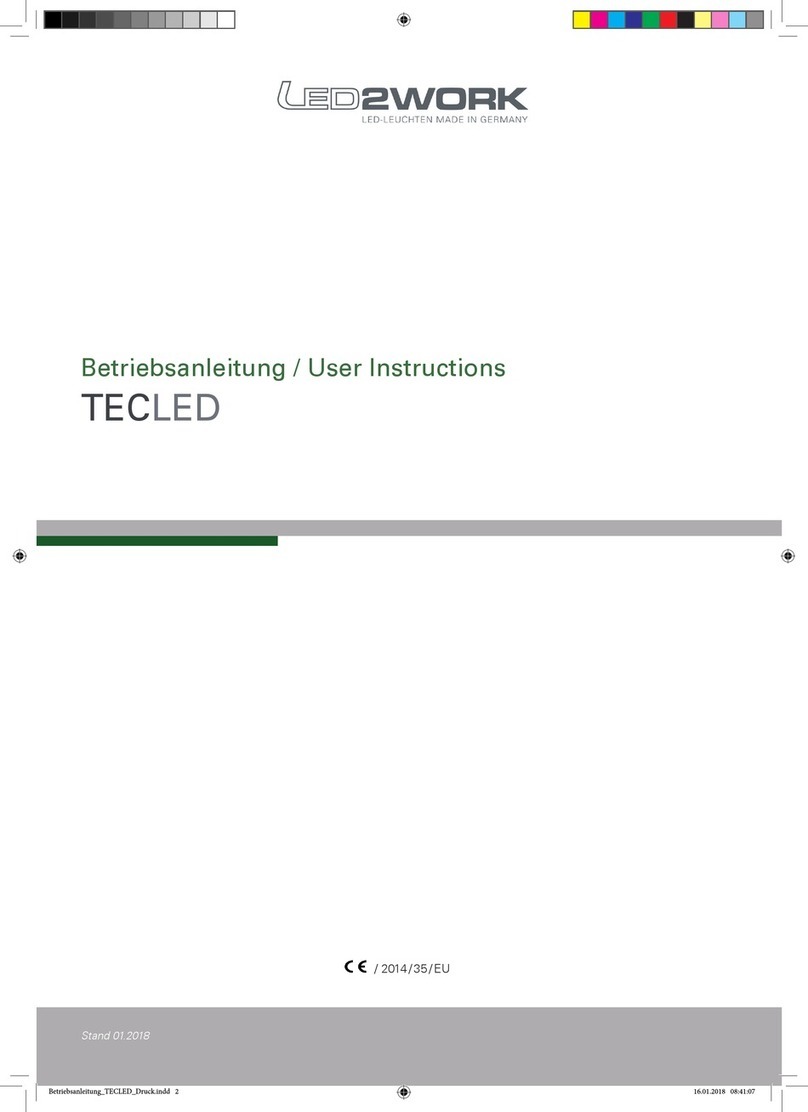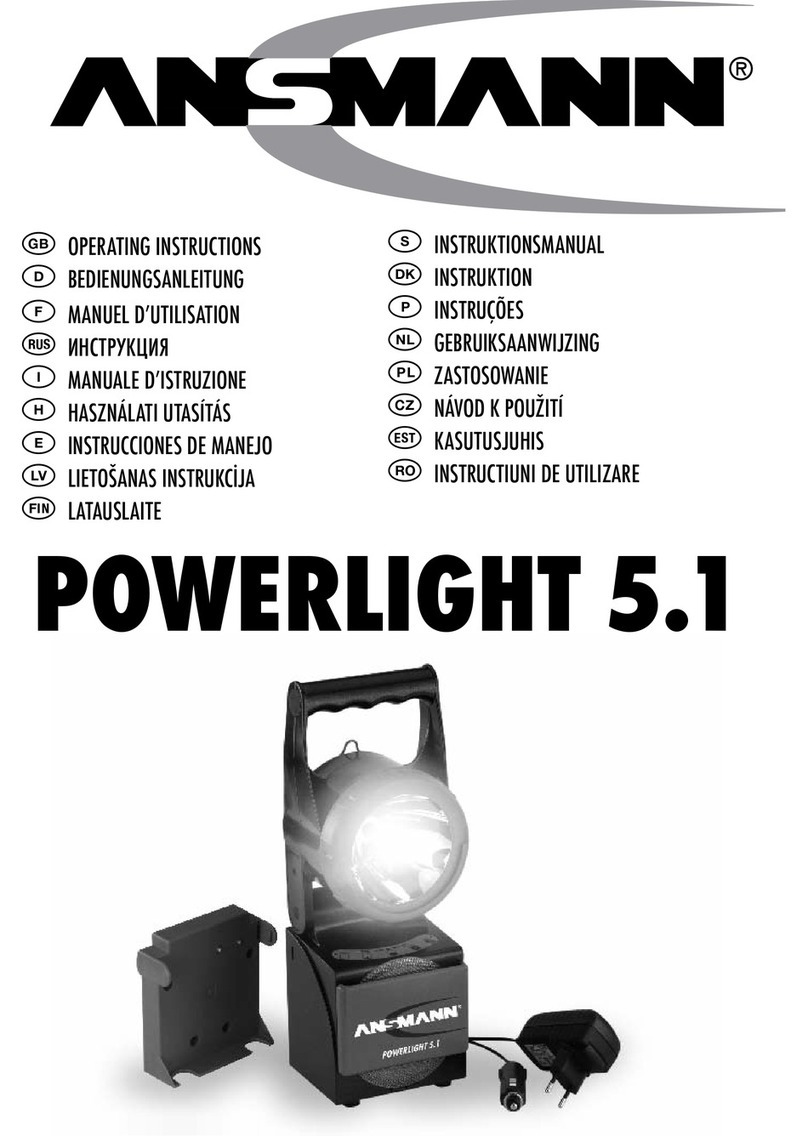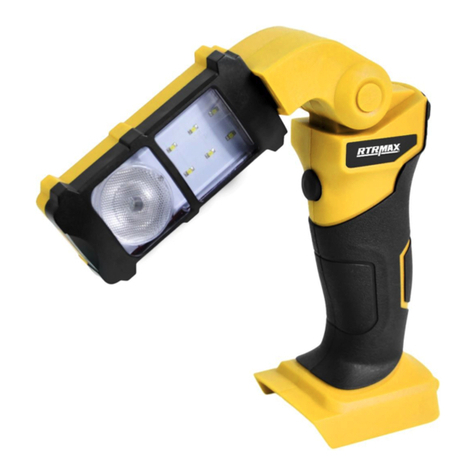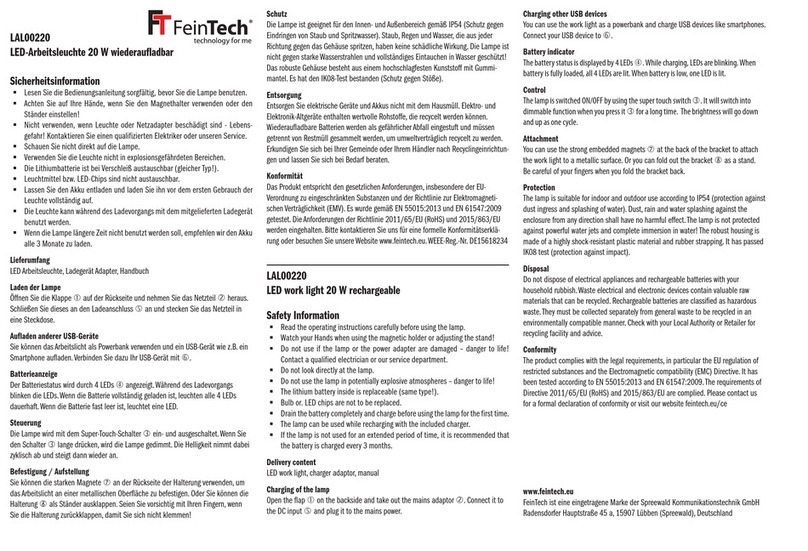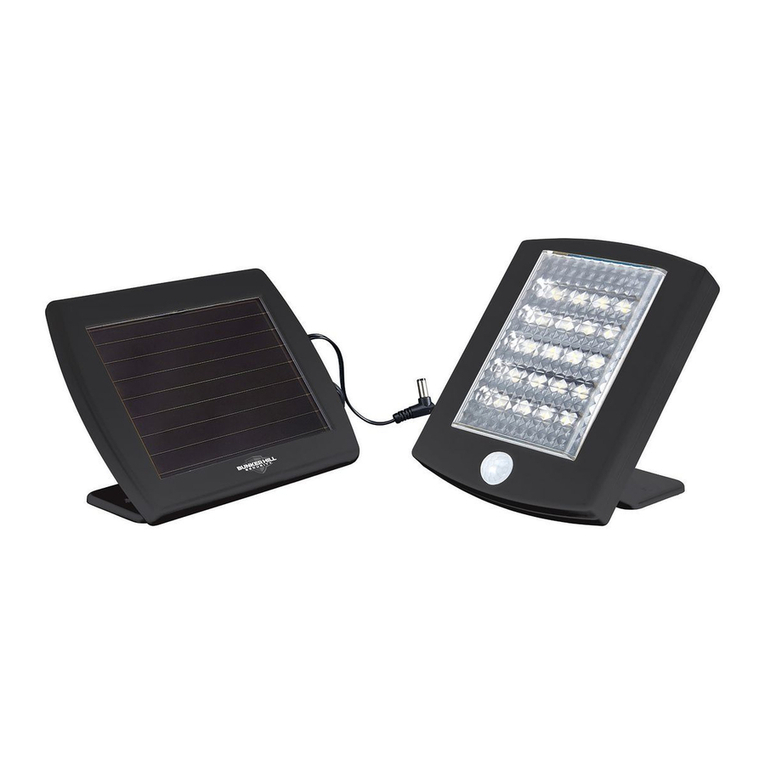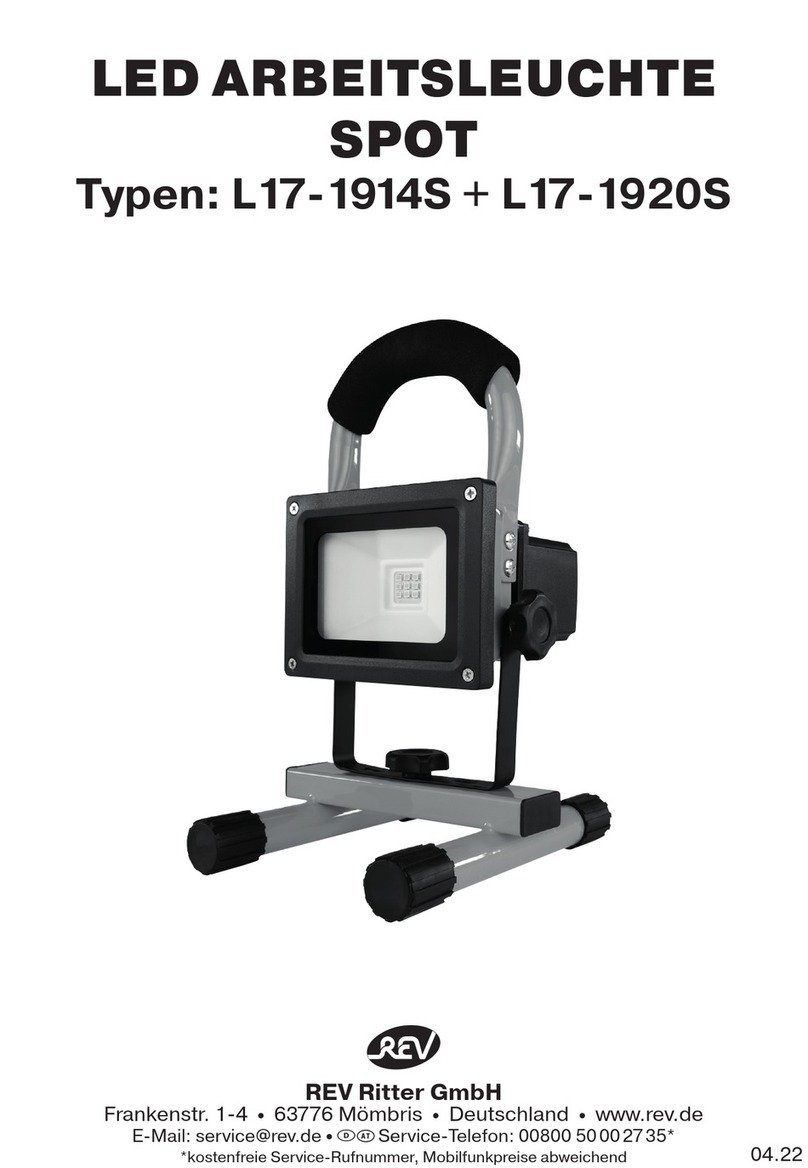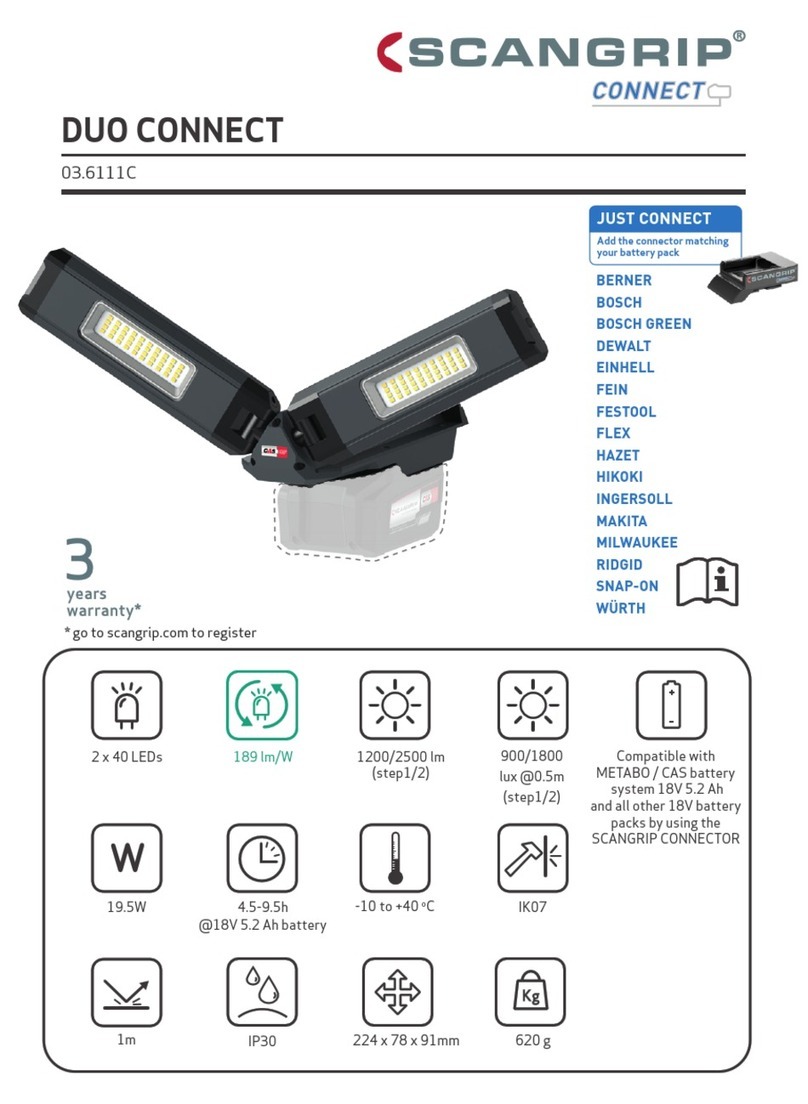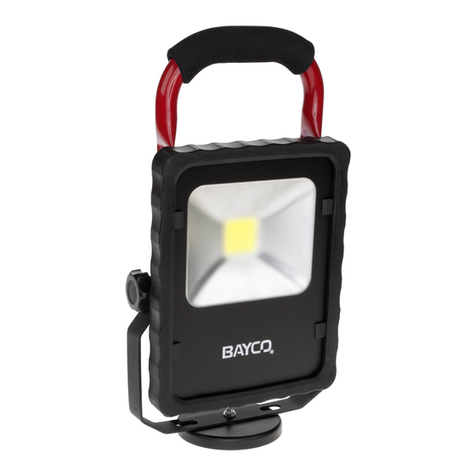67
LIGHT OPERATION
WARNING
To reduce the risk of
injury, do not look directly into the light when
the light is on. Using the Light
1. Insert battery pack or plug into AC power.
2. Press the Power button to turn on the light.
NOTE: When the light is running on battery, the
Battery Power Indicator will light. When
the light is running on AC power, the AC Power
Indicator will light.
3. Press the Increase +and Decrease −buttons to
cyclethrough High, Medium, and Low brightness.
NOTE:Thelight will default to the selected bright-
ness the next time it is turned on.
4. Press the Power button to turn the light off.
Always turn off power before unplugging the light.
BATTERY OPERATION
Fuel Gauge
Use the Fuel Gauge to determine the battery pack's
remaining run time. Press the Fuel Gauge button to
display the lights. The Fuel Gauge will light up for
2-3 seconds. When less than 10% of charge is left,
1 light on the fuel gauge will flash slowly.
78-100%
55-77%
33-54%
10-32%
Less than 10% if bottom light is flashing
Approximate Run
Time Remaining
NOTE: If the Fuel Gauge doesn't appear to be
working, place the battery pack on the charger and
charge as needed.
Comparedto NiCd batterypack types, MILWAUKEE
Lithium-Ionbattery packs deliver fade-free power for
their entire run time. The tool will not experience a
slow, gradual loss of power as you work. To signal
the end of discharge, 1 light on the fuel gauge will
flashquickly for 2-3seconds and thetool will not run.
Charge the battery pack.
NOTE: Immediately after using the battery pack,
the Fuel Gauge may display a lower charge than it
will if checked a few minutes later. The battery cells
"recover" some of their charge after resting.
Battery Pack Protection
To protect itself from damage and extend its life, the
batterypack’sintelligentcircuit monitors current draw
and temperature. In extremely high torque, binding,
stalling, and short circuit situations, the battery pack
will turn OFF the tool if the current draw becomes
too high. All the fuel gauge lights will flash. Release
the trigger and restart.
Under extreme circumstances, the internal tem-
perature of the battery could become too high. If
this happens, the fuel gauge lights will flash in an
alternating pattern and the tool will not run.Allow the
battery to cool down.
Fuel Gauge Lights Diagnosis Solution
Lights 1 - 4 Solid Remaining run time Continue working
1 Light, flashing
slowly Less than 10% run
time left Prepare to charge pack
1 Light, flashing
quickly End of discharge Charge pack
Lights 1-4, flashing
quickly Current draw too
high Release trigger and
restart, reduce pressure
Lights 1&3 / 2&4,
flashing alternatingly Battery temperature
too high Release trigger and allow
battery to cool
Cold Weather Operation
MILWAUKEELithium-Ion battery packsare designed
to operate in temperatures below freezing. When
the battery pack is too cold, it may need to warm up
before normal use. Put the battery on a tool and use
thetool in a light application.It may “buzz”for a short
time until it warms up. When the buzzing stops, use
the tool normally.
Maintenance and Storage
Do not expose your battery pack or cordless tools
to water or rain, or allow them to get wet. This could
damage the tool and battery pack. Do not use oil or
solvents to clean or lubricate your battery pack. The
plastic casing will become brittle and crack, causing
a risk of injury.
Store battery packs at room temperature away from
moisture. Do not store in damp locations where cor-
rosion of terminals may occur. As with other battery
packtypes, permanent capacity loss canresult if the
pack is stored for long periods of time at high tem-
peratures (over 120° F). MILWAUKEE Lithium-Ion
battery packs maintain their charge during storage
longer than other battery pack types. After about a
year of storage, charge the pack as normal.
Transport
Personal transport of Li-Ion battery packs is allowed
when done in accordance with these warnings and
instructions.Theproper classification, packaging, la-
beling,marking,and documentation requirements for
shipping Li-Ion batteries is dependent upon whether
the particular batteries are rated greater than or less
than100Wh (WattHourscan be found onthe battery
pack nameplate). Generally, Li-Ion batteries rated
100 Wh or less are “excepted” from certain Class 9
DGrequirements.Always check compliance ofLi-Ion
batteryconsignments against the currentregulations
governing the chosen mode of transport. When in
doubt,contact the carrieror other trainedDangerous
Goods professional to confirm acceptability. Li-Ion
packs are shipped under classification UN 3480
(battery only) or UN 3481 (batteries contained in or
packed with equipment).
WARNING
To reduce the risk of
injury or explosion, never burn or incinerate a
battery pack even if it is damaged, dead or com-
pletely discharged. When burned, toxic fumes
and materials are created.
Disposing of MILWAUKEE Lithium-Ion
Battery Packs
MILWAUKEE Lithium-Ion battery packs are more
environmentally friendly than some other types of
power tool battery packs (e.g., nickel-cadmium).
Always dispose of your battery pack according to
federal, state and local regulations. Contact a re-
cycling agency in your area for recycling locations.
Evendischargedbattery packs containsomeenergy.
Before disposing, use electrical tape to cover the
terminals to prevent the battery pack from shorting,
which could cause a fire or explosion.
RBRC Battery Recycling Seals
The RBRC™ Battery Recycling Seals (see "Sym-
bology") on your tool battery packs indicate that
MILWAUKEE has arranged for the recycling of
that battery pack with the Rechargeable
Battery Recycling Corporation (RBRC).
CHARGER OPERATION
WARNING
Charge only MIL-
WAUKEE M18™ Lithium-Ion batteries in this
MILWAUKEE Lithium-Ion charger. Other types of
batteries may cause personal injury and damage.
When to Charge the Battery Pack
Remove the battery pack from the tool for charging
when convenient for you and your job. MILWAUKEE
batteries do not develop a "memory" when charged
after only a partial discharge. It is not necessary to
run down the battery pack before placing it on the
charger.
• Use the Fuel Gauge to determine when to charge
your MILWAUKEE Lithium-Ion battery pack.
• You can "Top-Off" yourbattery pack's charge before
starting a big job or long day of use.
•The only time it is necessary to charge the
MILWAUKEE Lithium-Ion battery pack is when the
battery pack has reached the end of its charge. To
signal the end of charge, power to the tool will drop
quickly, allowing you just enough power to finish
making a cut, drilling a hole, or driving a fastener.
Charge the battery pack as needed.
How to Charge the Battery Pack
Plugthelightinto a 120V outlet. The battery packs will
not charge if the Stand Light Charger is not plugged
in. Align the battery pack with the bay and slide the
battery pack into the charger as far as possible.
• When a battery pack is inserted into the charger,
the LEDs will indicate the following:
Continuous red: Charging
Continuous green light: Charging is complete
Flashing red: Battery is too hot/cold
Charging will begin when battery reaches
correct charging temperature
Flashing red/green: Damaged or faulty battery
pack
•A fully discharged battery pack with an internal
temperatureinthe normal range willchargein about
30 to 185 minutes, depending on the battery pack.
• Heavily cycled batteries may take longer to charge
completely.
•The Fuel Gauge lights on the battery pack are
displayed as the pack is being charged, indicating
how fully charged the pack is. The fuel gauge will
turn off when charging is complete.
• After charging is complete, the continuous green
light will come on.
• The charger will keep thebattery pack fully charged
ifit is lefton the charger. The light indicator will flash
green during this maintenance charging.
• If the light indicator flashes red and green, check
that the battery pack is fully seated into the bay.
Remove the pack and reinsert. If the problem per-
sists, contact a MILWAUKEE service facility.
• If thelight indicator doesnot come on,check that the
batterypackisfully seated into the bay. Removethe
battery pack and reinsert. If the light indicator still
does not come on, contact a MILWAUKEE service
facility.
Charging a Hot or Cold Battery Pack
The Red Flashing Indicator light on the charger in-
dicates that the battery pack temperature is outside
the charging range. Once the battery pack is within
theacceptablerange, normal charging willtake place
and the red light will be continuous. Hot or cold bat-
teries may take longer to charge.
Lithium-Ion Charging Status
Battery Pack
Temperature Red Charger
Indicator Light Charging Status
Too Hot
Normal Range
Too Cold
Fast Flashing
Continuous
Fast Flashing
Not charging
Normal charging
Not charging
MAINTENANCE
WARNINGTo reduce the risk of
injury, always unplug the charger and remove the
battery pack from the charger before performing
any maintenance. Never disassemble the tool,
battery pack or charger. Contact a MILWAUKEE
service facility for ALL repairs.
Maintaining Light
Keep your light, battery pack and charger in good
repair by adopting a regular maintenance program. If
the light does not work properly, return the light to a
MILWAUKEE service facility for repairs.
Tightening
If the head or extensions will not hold their position,
the screws may need to be tightened. Tighten the
bracket screws by holding the head. Tighten the ex-
tension latches by opening the latches and tightening
the screw inside.
WARNINGTo reduce the risk of
personal injury and damage, never immerse your
tool, battery pack or charger in liquid or allow a
liquid to flow inside them.
Cleaning
Clean dust and debris from vents. Keep handles
clean, dry and free of oil or grease. Use only mild
soap and a damp cloth to clean, since certain clean-
ing agents and solvents are harmful to plastics and
other insulated parts. Do not use sprays or solvents.
Some of these include gasoline, turpentine, lacquer
thinner, paint thinner, chlorinated cleaning solvents,
ammonia and household detergents containing am-
monia.Neveruse flammable or combustiblesolvents
around tools.
When it comes to quality work lights, Milwaukee is the brand you can depend on.
